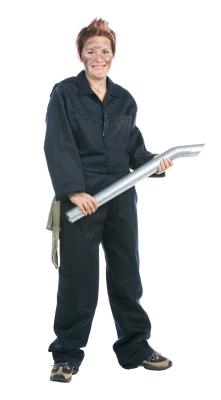
There are two types of curves, and calculations to be aware of when angling pipes off a common centerline. Pipe benders, a tool used for bending metal pipes, automatically calculates the “bend allowance,” removing the need for individual measurements. A trigonometry based calculation, the “cosecant,” is the second measurement to take into consideration when adding angles off a centerline.
Draw all your pipe angles on graph paper with a pencil before you begin. Include the diameter of the pipes you will use, and the angle and radius of all straight line and offset curves.
Determine the length of the straight pipe you will need by predetermining the length of the straight lines and offset curves.
Use a calculator to determine the exact length of the straight pipe; multiply the centerline radius of the pipe by the degree of the bend you will make, then by the constant .01745. A straight line curve is a curve that bends a pipe up or down in only two dimensions so that the straight part of the bent pipe may lay flat, if on a table.
Calculate the length of straight pipe you will need to make offset curves by determining the cosecant of the angle of the pipe bend tool or by using the cosecants equation. To determine the cosecant is the length of the hypotenuse of a 90º triangle divided by the length of the opposite side of the triangle.
Examples of common bends run as such: a 10 degree bend has a cosecant of 5.76; a 22.5 degree bend has a cosecant of 2.6; a 30 degree bend, the most popular, has a cosecant of two; a 45 degree bend has a cosecant of 1.414; and a 60 degree bend has a cosecant of 1.15.
Multiply the depth of the offset, by the cosecant of the offset angle, to determine the length of straight pipe you will need to include an offset bend. An offset bend is a bend in a straight pipe that sticks up when laied flat. The depth of the offset is the height the pipe sticks up from the table.
Determine the total length of straight pipe you will need to make all the bends you have planned and mark your straight pipe accordingly, using a steel ruler and a scratch awl.